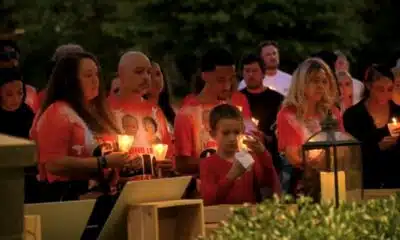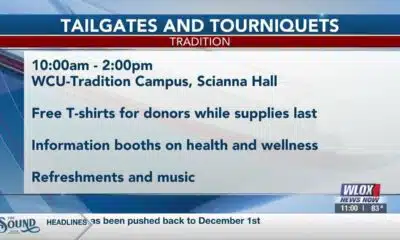News from the South - Missouri News Feed
How does Missouri’s investment in a behavioral health crisis network improve mental health care?
by Meg Cunningham, Missouri Independent
July 1, 2025
For years, Missouri has sought to address a growing mental and behavioral health crisis that touches every corner of the state.
In 2024, Missouri was ranked 38th nationwide when it came to prevalence of mental illness and overall access to treatment. So the state made multimillion-dollar investments to improve responses when Missourians are in moments of crisis.
For decades, calling 911 or going to the emergency room was the norm if a person was experiencing a mental health crisis.
Now, with the rollout of a statewide network in tandem with the national crisis hotline, 988, Missouri’s behavioral health providers dispatch teams of social workers or other specialists to be there for someone experiencing a crisis, at no cost to them.
“Not everything requires a level 10 response,” said Jamie Manning, the vice president of access and urgent care services at Compass Health Network. “Outside of calling 911, there’s now this free, accessible service, and you don’t have to wait until it’s that bad. You don’t have to go to the hospital when you’re at your wits’ end. We can help you before it gets to that point.”
Missouri currently has 20 behavioral health centers in the mobile crisis response network statewide. If a person dials 988 in the midst of a crisis and they need more support than is available through a phone call, the providers in the network will send out a team of two behavioral health workers to help them through their crisis.
“For many, many years, there weren’t other options,” Manning said. “Thank goodness we have new resources so there’s now that in between.”
How mobile crisis came online as part of Missouri’s mental health response
Many behavioral health providers, especially those serving rural patients, had some form of a mobile crisis response in place even before the state launched its network in tandem with 988.
As a caseworker early in her career, Manning remembers the toll that mobile response calls could have on staff. Workers were on call outside of their typical working hours, which meant more work and management for caseworkers outside of their day-to-day responsibilities.
But with the launch of 988 and an investment in the statewide mobile crisis network, behavioral health providers were able to hire full-time staff and create separate mobile teams whose purpose is to go out into the community and respond to the calls.
For fiscal years 2025 and 2026, Missouri set aside about $15 million annually that trickles down to behavioral health providers to staff and fund their mobile crisis teams. And the investment is changing the way the state responds to mental health crises.
“They are trained behavioral health professionals that will respond to a situation without law enforcement,” said KC Rafferty, the director of community engagement at the Missouri Behavioral Health Council.
The goal is to get to the root cause of someone’s crisis moment and get them connected to care that better fits their needs.
“If we’ve seen this person over and over and over again, how can we maybe think differently, think outside the box, to engage with them and ensure that they are getting the appropriate care for what they need?” Rafferty said.
In 2024, the 988 hotline in Missouri answered nearly 85,000 calls, 20,500 texts and nearly 8,800 chats. Of those contacts, about 3,000 — or just over 2.7% — resulted in a mobile crisis team being dispatched.
So far in 2025, 3.08% of contacts result in a mobile team heading out into the state, data provided by the Department of Mental Health shows.
Providers go to a patient’s home or meet them at a more public location, like a library or parking lot. After responding to a call and deescalating the situation, providers offer the opportunity to check back in with patients in the days following a crisis. They offer them options for short- or long-term care and treatment, or other assistance, such as helping them fill out Medicaid applications or making a doctor’s appointment.
But each case is different, and challenges remain when treating behavioral health conditions, especially in rural areas.
“Whenever we’re talking about rural mobile response, it’s the culture,” said Natasha Corkins, the director of crisis services for Burrell Behavioral Health’s southwest region, which covers Springfield and six surrounding counties. “There are people who call and want to speak, and we offer a mobile response and they’re hesitant because they don’t want to invite someone to their home or their location.”
“Consent is very important to us, because a crisis is a very individual and intimate situation,” Corkins said. “We don’t want to show up and possibly escalate a crisis by our presence. We want them to invite us in.”
Another challenge posed in rural communities is access to the internet when people are ready to seek out resources, Rafferty said.
“That can pose its own threat if they don’t have the ability to get where they need help, or to call someone to get assistance, if there is poor coverage in their area,” Rafferty said.
In all behavioral health responses, patience and understanding are key to better outcomes for patients, said Laurie Cox, the director of crisis services at Swope Health in Kansas City.
“If you keep getting in crisis, the only way to stop that is to get the services that you need,” Cox said. “But we also know that it is really hard for people to do. So it takes patience, it takes determination, it takes knowing how hard to push.”
Shifting from 911 and emergency rooms to living rooms and libraries
Emergency responders and behavioral health workers agree that an emergency room or a jail cell isn’t the best place for someone who is experiencing a crisis. But for many years, it was the only option.
Now, if it is safe, emergency medical services and law enforcement don’t need to be on-site at many of the 988 mobile dispatches, because there are mobile responders across the state trained in deescalation.
And they say the number of behavioral health calls they are needed for has dropped as the option becomes better known.
“If we go back and look at repeat patients, a lot of those have significantly decreased because they are getting the follow-up they need,” said Chris Bogguss, the director of EMS in Macon County. “They were given the appropriate resources.”
And for situations where emergency responders are needed at a behavioral crisis call, Missouri is incentivizing them to receive crisis intervention training in how to assess and deescalate crisis calls.
“It’s the education that we’ve received outside of our traditional EMS training that’s really helped us … better understand the patient’s needs,” Bogguss said.
Burrell Behavioral Health’s southwest coverage area has a crisis hotline specialist embedded in the Springfield-Greene County 911 dispatch center.
“We can work on diverting crisis callers from 911 to our crisis team, and hopefully stop the dispatching before it happens,” Corkins said.
Ultimately, providers want Missourians to know they can reach out for help and get connected to support or services through the 988 network.
“The goal is not to provide the Band-Aid in the moment, although that has its benefits,” Manning said. “How can we ensure that this has some lasting impact? It’s not a one and done. We’re here for you in whatever capacity you’re open to.”
This article first appeared on Beacon: Kansas City and is republished here under a Creative Commons Attribution-NoDerivatives 4.0 International License. PARSELY = { autotrack: false, onload: function() { PARSELY.beacon.trackPageView({ url: “https://thebeaconnews.org/stories/2025/06/25/missouri-mental-health-988-mobile-crisis-network/”, urlref: window.location.href }); } }
Missouri Independent is part of States Newsroom, a nonprofit news network supported by grants and a coalition of donors as a 501c(3) public charity. Missouri Independent maintains editorial independence. Contact Editor Jason Hancock for questions: info@missouriindependent.com.
The post How does Missouri’s investment in a behavioral health crisis network improve mental health care? appeared first on missouriindependent.com
Note: The following A.I. based commentary is not part of the original article, reproduced above, but is offered in the hopes that it will promote greater media literacy and critical thinking, by making any potential bias more visible to the reader –Staff Editor.
Political Bias Rating: Center-Left
This article presents a largely factual overview of Missouri’s mobile mental health crisis response efforts, emphasizing increased public funding, de-escalation without police, and access to care. The tone is supportive of government intervention in mental health services and highlights challenges in rural access, equity, and alternatives to law enforcement — positions often associated with center-left public health policy. While it does not criticize opposing views, its consistent framing of these developments in a positive light and emphasis on systemic reform suggests a Center-Left bias focused on progressive health and social service expansion.
News from the South - Missouri News Feed
Luke Altmyer scores 3 TDs, No. 9 Illinois shuts out Western Michigan, 38-0
SUMMARY: No. 9 Illinois defeated Western Michigan 38-0, extending its winning streak to seven games, the longest since 2011. Quarterback Luke Altmyer threw two touchdowns and ran for another, while Kaden Feagin rushed for 100 yards and a touchdown. Illinois’ defense made critical stops, preserving the shutout despite only leading 10-0 at halftime. Coach Bret Bielema expressed frustration at the team’s slow start. Illinois remains turnover-free this season and has outscored opponents 128-22 in three games. Their next challenge is Big Ten play against No. 22 Indiana. Western Michigan starts MAC play next week against Toledo.
The post Luke Altmyer scores 3 TDs, No. 9 Illinois shuts out Western Michigan, 38-0 appeared first on fox2now.com
News from the South - Missouri News Feed
Panic and chaos at a St. Louis area mall false reports of shots fired
SUMMARY: Panic erupted at West County Center mall in the St. Louis area Saturday around 2:30 p.m. after a false report of shots fired in the food court. Police arrived quickly but found no active shooter. The confusion stemmed from a fight where a chair was thrown, causing fear among shoppers. Maya Emig, separated from her family, was comforted by strangers during the chaos. Traffic snarled as parents tried to reach their children. The incident, amid recent nationwide gun violence, heightened fears but no arrests were made. Authorities confirmed no guns were involved and no charges will be filed.
A fight near the food court where a chair was thrown at a victim caused some confusion, which then turned into panic and chaos amid rumors of an active shooter.
News from the South - Missouri News Feed
UTVs, ROVs may soon be allowed on Wentzville streets
SUMMARY: Wentzville’s Board of Aldermen voted 4-2 to allow utility terrain vehicles (UTVs) and recreational off-highway vehicles (ROVs) on city streets under conditions similar to golf cart rules. Use would be limited to subdivisions with speed limits of 25 mph or less, requiring valid licenses, insurance, and safety features. However, Mayor Nick Guccione vetoed the ordinance, citing safety and enforcement concerns, supported by residents and officials. The Board may override the veto on September 24. Supporters emphasize personal responsibility, while opponents worry about public safety. Enforcement challenges exist, especially regarding underage drivers. Missouri law permits municipalities to regulate such vehicles locally.
Read the full article
The post UTVs, ROVs may soon be allowed on Wentzville streets appeared first on fox2now.com
-
News from the South - Kentucky News Feed6 days ago
Lexington man accused of carjacking, firing gun during police chase faces federal firearm charge
-
The Center Square7 days ago
California mother says daughter killed herself after being transitioned by school | California
-
News from the South - Arkansas News Feed6 days ago
Arkansas medical marijuana sales on pace for record year
-
News from the South - Alabama News Feed6 days ago
Zaxby's Player of the Week: Dylan Jackson, Vigor WR
-
Local News Video7 days ago
William Carey University holds 'tailgates and tourniquets' blood drive
-
News from the South - North Carolina News Feed5 days ago
What we know about Charlie Kirk shooting suspect, how he was caught
-
News from the South - Missouri News Feed6 days ago
Local, statewide officials react to Charlie Kirk death after shooting in Utah
-
Local News6 days ago
US stocks inch to more records as inflation slows and Oracle soars














































